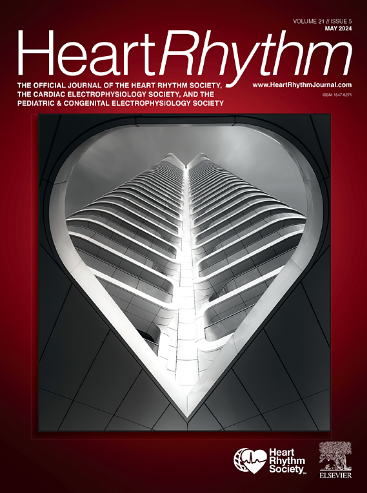既往消融失败患者再次消融治疗室性早搏的结果:先进技术的影响
IF 5.6
2区 医学
Q1 CARDIAC & CARDIOVASCULAR SYSTEMS
引用次数: 0
摘要
背景:对先前消融失败的室性早搏(PVC)患者进行重复消融的效用尚不明确:目的:评估重复消融术的效果以及不同技术在先前 PVC 消融术失败患者中的应用:我们对 239 例连续接受 PVC 消融术的患者进行了回顾性研究。当使用正常生理盐水或半正常生理盐水进行标准心内膜消融失败时,我们考虑使用高级消融技术。急性成功的定义是目标 PVC 消失。结果显示,在239名患者中,75人(31%)接受了先进的消融术:结果:在 239 名患者中,75 名(31%)患者之前的消融术失败,他们更多的是 LVOT PVC。尽管之前的消融术失败了,但59%的患者重复标准消融术获得了急性成功,其中75%的患者获得了长期成功。与未进行过消融术的患者相比,急性标准消融成功率较低,长期复发率较高(59% vs 95%;PC结论:虽然之前消融失败的患者成功率较低,但对许多患者来说,重复消融似乎是合理的,而且先进技术的使用使这组患者的成功率提高到了 71%。本文章由计算机程序翻译,如有差异,请以英文原文为准。
Outcome of repeat ablation for premature ventricular contractions in patients with prior ablation failure: Impact of advanced techniques
Background
The utility of repeat ablation for premature ventricular contractions (PVCs) after prior ablation failure is not clear.
Objective
The purpose of this study was to assess the outcomes of repeat ablation and the use of different techniques in patients who failed prior PVC ablation.
Methods
We reviewed 239 consecutive patients who underwent PVC ablation. When standard endocardial ablation with normal or half-normal saline failed, we considered an advanced ablation technique. Acute success was defined as abolition of the target PVC. Clinical and procedural findings, PVC origins, and acute and follow-up outcomes were compared in those with and without a prior failed ablation procedure.
Results
Of 239 patients, 75 (31%) had failed a prior ablation procedure, and they more often had left ventricular outflow tract PVCs. Despite failing prior ablation, repeat standard ablation was acutely successful in 59% of patients, and 75% of these patients had long-term success. Acute standard ablation success rate was lower and long-term recurrence rate was higher than in patients without prior ablation (59% vs 95%, P <.001; and 29% vs 17%, P <.05, respectively). Of the 31 repeat standard procedures that again failed, advanced techniques were performed in 23 (16 needle, 5 epicardial, 2 simultaneous ablation) and were acutely successful in 16 (70%) with long-term success in 14 (45%). Overall long-term success for patients with prior failed standard ablation was 71%.
Conclusion
Although success is lower for patients with prior failed ablation, repeat ablation seems reasonable for many, and the use of advanced techniques increased success to 71% in this group.
求助全文
通过发布文献求助,成功后即可免费获取论文全文。
去求助
来源期刊

Heart rhythm
医学-心血管系统
CiteScore
10.50
自引率
5.50%
发文量
1465
审稿时长
24 days
期刊介绍:
HeartRhythm, the official Journal of the Heart Rhythm Society and the Cardiac Electrophysiology Society, is a unique journal for fundamental discovery and clinical applicability.
HeartRhythm integrates the entire cardiac electrophysiology (EP) community from basic and clinical academic researchers, private practitioners, engineers, allied professionals, industry, and trainees, all of whom are vital and interdependent members of our EP community.
The Heart Rhythm Society is the international leader in science, education, and advocacy for cardiac arrhythmia professionals and patients, and the primary information resource on heart rhythm disorders. Its mission is to improve the care of patients by promoting research, education, and optimal health care policies and standards.
 求助内容:
求助内容: 应助结果提醒方式:
应助结果提醒方式:


